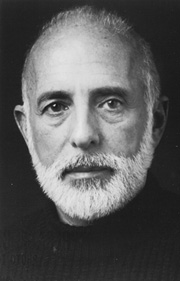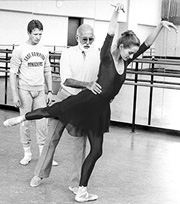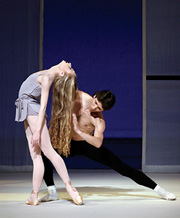A Posthumous Party
Celebrating the works of Jerome Robbins
By Marene Gustin. Photo by Martha Swope

Legendary dancer/choreographer/director Jerome Robbins would have been 90 this year, and Broadway and ballet are celebrating.
Ten years after his death, his works are being mounted in ballet companies around the world, and a revival of his classic West Side Story is headed to Broadway next February.
“I feel like he’s a very human choreographer,” Houston Ballet’s artistic director, Stanton Welch, says of Robbins’ ongoing popularity. “You might look at West Side Story and think ‘that’s a ’50s piece,’ but it is still riveting. It’s timeless.”
Welch, who added Robbins’ The Concert to the company’s repertory last year, adds the Houston premiere of his Afternoon of a Faun this year in the Classically Modern program September 18 through 28. “And I would love to add more—The Cage, West Side Story Suite, Interplay. There’s a vault of his work—we could add a new one every year and not run out.”
Welch saw Robbins in rehearsal once, as a kid on scholarship in New York City. “He was a very intimidating man,” he remembers.
Bart Cook, who is setting Afternoon of a Faun on Houston Ballet, remembers a lot more.

“There was one rehearsal of The Concert and he was laughing and he jumped up and did the whole role; it was wonderful the way he did it,” Cook, a former dancer and assistant ballet master to Robbins at New York City Ballet, recalls. “I learned so much from him that day. Then the next day he was a total prick.”
Born Jerome Rabinowitz in 1918, Robbins was a product of the times, his Jewish family, and his own sexuality. By some accounts he was engaged to ballerina Nora Kaye while in the midst of a long-term affair with Broadway dancer Buzz Miller. He was also linked to actor Montgomery Clift and, according to dance critic Deborah Jowitt’s Jerome Robbins: His Life, His Theater, His Dance, he dodged the draft in World War II by admitting to being homosexual.
But his fear of being outed publicly, or perhaps being blacklisted on Broadway, may have been behind his darkest moment when in 1953 he gave a list of names to McCarthy’s Un-American Activities Committee.
“I had only been in the company a few years in 1974,” Cook says, “when we toured Russia. He was so paranoid about the Communists. We were going to four cities and he didn’t even make it through Moscow. He had to up and leave.”
But even more than by that Russian episode, Cook thinks that Robbins was driven by the demon of early success. His first ballet Fancy Free and his first Broadway smash On the Town made him a boy genius while still in his 20s.
“He had a lot of self-inflicted pressure,” Cook says. “He was such a success at such a young age, and he felt he had to live up to that. He had a lot of baggage; you either deal with it and use it creatively—it ends up in a ballet or a musical—or you end up in prison.”

Robbins used it creatively. From ballets to Broadway to movies, he continued to create American classics like The King and I, Gypsy, Fiddler on the Roof, Dances at a Gathering, The Cage, and The Goldberg Variations. And while much of his work in the ballet world was in the shadow of his mentor George Balanchine, his work is still being performed today.
“I absolutely think his work will still be relevant 10 years from now,” Welch muses futuristically about the 100th anniversary of Robbins’ birth.
As to whether there will be more Robbins tributes then, Cook is less optimistic. “If ballet companies need something to sell, yes,” he says. “Who knows if the economy will still be supporting ballet in 10 years, but they should.”
Marene Gustin also profiled Matthew Dirst and Jonathon Glus for this issue of OutSmart.
PHOTO CAPTIONS
Jerome Robbins was as philosophical about life itself as he was about dance. In 1992, he told the International Herald Tribune: “Dance is like life. It exists as you’re flitting through it, and when it’s over, it’s gone.”
Bart Cook (far left) looks on as legendary choreographer Jerome Robbins stabilizes Cook’s wife, ballerina Maria Calegari. Cook and Calegari danced in Robbins’ 1984 New York City Ballet production of Debussy’s Afternoon of a Faun, which Cook is mounting for Houston Ballet, September 18–28.
Janie Taylor (l) and Damian Woezel are principal dancers in Debussy’s Afternoon of a Faun, originally choreographed by Jerome Robbins and staged this month for Houston Ballet by Bart Cook.











Comments